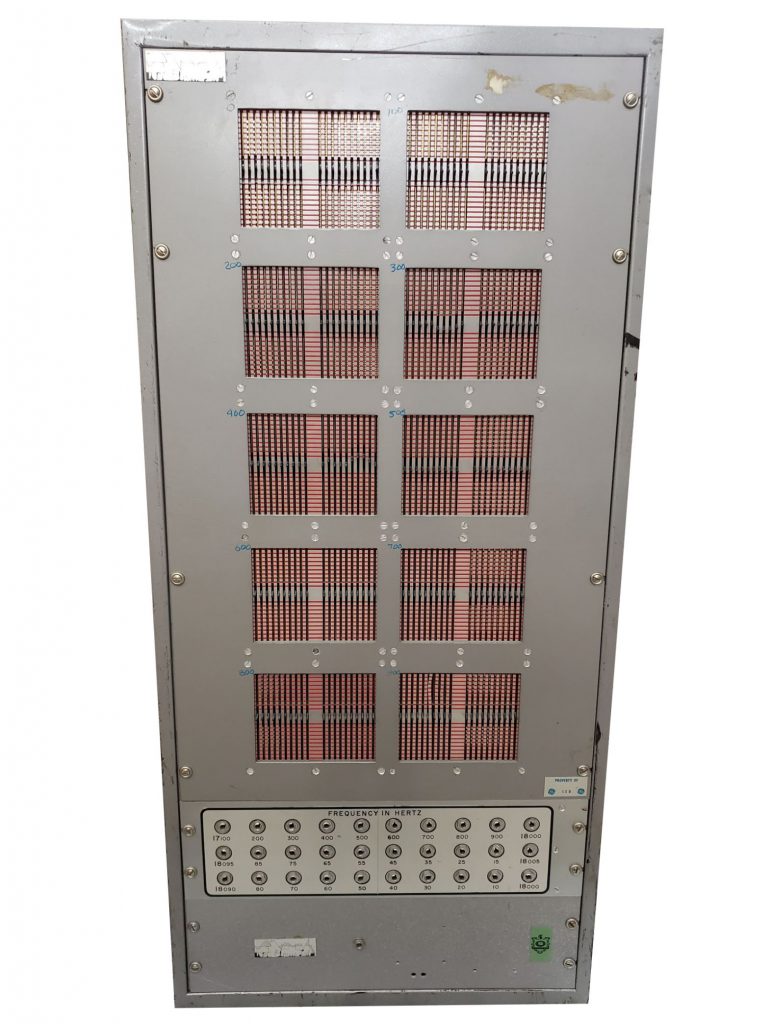Artefacts
Sonde
Sonde
(Accession Number: 1986.0154)
Dimensions: Height = 112cm, Length = 52cm, Width = 35cm
Condition: Mechanical components in good condition. Electronic components in fair condition.
The Sonde is a studio-oriented musical instrument designed by Canadian physicist Hugh Le Caine and built in the National Research Council of Canada’s (NRC) Electronic Music (ELMUS) Lab in Ottawa, Canada. It was created to facilitate experimentation in additive electronic sound synthesis. Unlike subtractive sound synthesis, in which a complex waveform is “shaped” by filtering or removing different frequencies, additive synthesis requires building up a complex waveform through the simultaneous introduction of multiple simple waveforms. Previously this would have been achieved by recording multiple versions of simple waveforms on tape, and then re-recording these waveforms onto more and more tapes until the required number of source waveforms (ingredients) necessary to achieve the desired complex waveform (mix) had been reached. This approach was not only time-consuming but it also had a negative impact on the final sound, as each subsequent tape recording introduced additional tape hiss (noise) into the mix. The Sonde overcame this problem by making it possible to electronically generate a large number of individual source waveforms within a single instrument – simultaneously, and on demand – thus eliminating the need to record and re-record individual waveforms on tape.
To achieve this feat, Le Caine designed the instrument as a matrix generator that could electronically produce up to 200 sine waves simultaneously, each tone generated by a slider that produced a specific frequency. Individual tones could be turned on or off, and the volume of each tone could be adjusted in real time. This allowed the composer to hear how each new sine wave or group of sine waves influenced the shape of the overall (complex) waveform, and impacted the final texture of the sound. The instrument employed 20 fixed-frequency oscillators and 10 converter-oscillators to derive the 200 pitches as combination tones, each with its own slider. While it could be played on its own, it was intended to be used in conjunction with other studio instruments. For example its register could be raised or lowered by recording the output and changing the playback speed through the Special Purpose Tape Recorder.
The Sonde is an expansion of the Oscillator Bank used in Le Caine’s 1964 composition Safari, where multiple sine tones are combined to form slowly-evolving clouds of sound. The Sonde simplified the process of sound control to the point where, while designed with studio composition in mind, it could have been used in live performance. A second, compact version – where each tone was activated by a touch-sensitive printed-circuit key – was built for the University of Toronto studio in 1970 under Le Caine’s supervision. Composers who later formed the Canadian Electronic Ensemble successfully performed live with this version of instrument.
The original Sonde shown here was built in 1968. Initially designed for experimental use in the ELMUS Lab, it was later sent to Queen’s University in Kingston, Canada. It is uncertain whether the instrument was transferred to Queen’s in the late 1960s, in support of the university’s newly-established electronic music studio, or in 1974, following Le Caine’s retirement from the NRC.
In 1986 Queen’s donated the Sonde to the National Museum of Science and Technology in Ottawa, Canada (now Ingenium – Canada’s Museums of Science and Innovation). The second, compact version of the Sonde was also donated to the museum, by the University of Toronto, in 1991. Both reside together in Ingenium’s permanent collection today.
© 2015 – 2024 Humboldt-Universität zu Berlin






